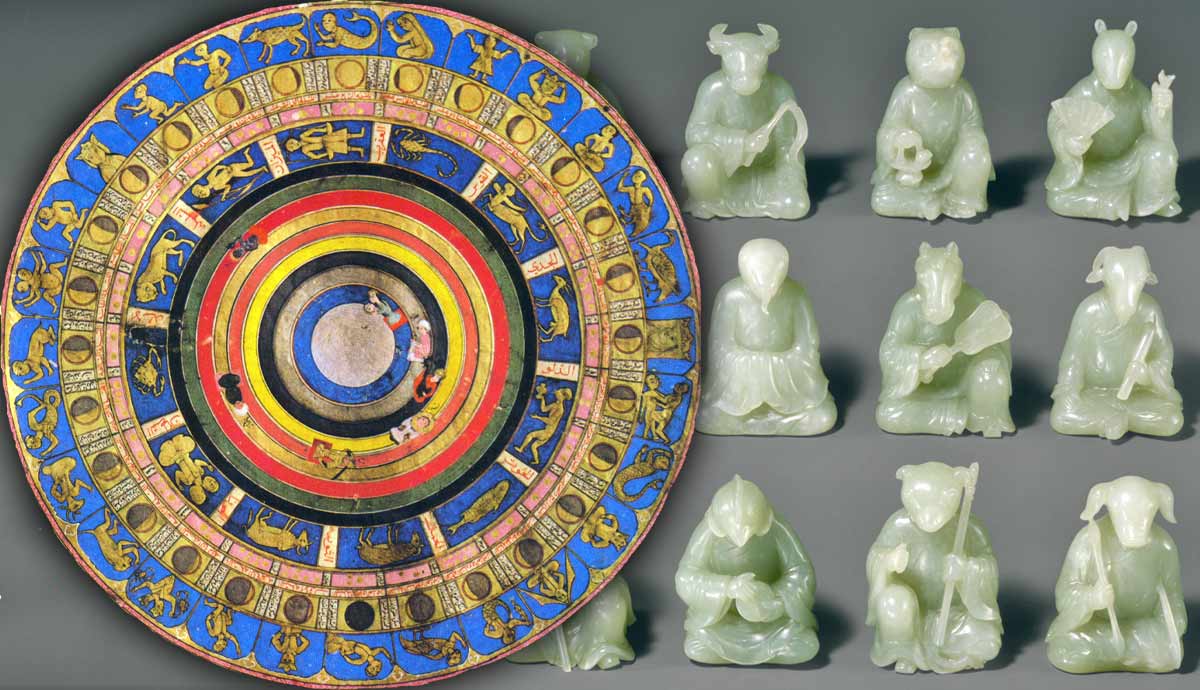
Astrology is the study of the positions of celestial entities and their prophetical influences on the human world. The zodiac refers to the region of the sky this covers. In ancient astrology, the sun and moon represented the most important deities for many ancient people. However, the sun disappears at night and the moon is mostly not visible during the day and is not visible at all during parts of its cycle. Contrastingly, the planets remain observable every night and therefore present themselves as reliable elements of an ever-changing cosmos.
Mesopotamian Astrology

While there are possible hints of the study of celestial bodies in relation to human activity in Sumerian tradition, the first conclusive evidence appears in the Old Babylonian period from around 2000 BCE. The Babylonians were aware of the sun, moon, and five of the solar system’s planets, which they connected with some of their most important deities: the sun with Shamash, the moon with Sin, Jupiter with Marduk, Venus with Ishtar, Mercury with Nabu, Mars with Nergal, and Saturn with Ninurta.
Interestingly, the gods associated with planets represented similar ideas to their better-known Greco-Roman counterparts; for example, Ishtar is a goddess associated with fertility as is Venus in the Roman tradition. Similarly, while the Babylonians originally acknowledged 18 constellations, they later concentrated on just twelve. As the Assyrians worshipped largely the same pantheon and had close cultural ties with the Babylonians, they adopted their astrological beliefs and practices, and later, the Hittites would implement these beliefs too.
Mesopotamian priests observed celestial phenomena and created predictions about the future through divination and liver models, whereby marks on the livers of sacrificed animals were used to interpret messages from the gods to kings and other people. On the livers, strange marks connected to certain planets were said to indicate the dissatisfaction of that god, and then subsequent measures would be taken to try and appease them.
The king was viewed as a mediator between the divine and human worlds, but it was the priests that aided the communication between them. As the study of astrology became more advanced, predictions became more nuanced and astrology could impart information on aspects of politics, the environment, and everyday life.
Greek and Roman Astrology

The Greeks merged their own astrological practices with Babylonian ideas during a time of heightened intellectual exchange with the Near East after the Greco-Persian Wars. By the time of Alexander the Great, Hellenistic astrology had become more popular and was still heavily influenced by astrologers from the Near East.
Later still, Berossus, a Chaldean priest, began teaching astrology in Kos and set up a school around 280 BCE. By this time, Hellenistic astrology was dominated by Greek philosophers, however, the Greeks still used the cosmology of the Near East and Egyptian beliefs.
A common Greek belief was that the cosmos was a connected whole. The system was used in court and could also be practiced on the street to predict individual destinies or favorable times to do something. It was utilized by many schools of thought, including those of Plato and Aristotle. The astrological houses (horoscopes dependent on time and place instead of date) seemingly emerged early in the Hellenistic Period, connected to a mythical Greek and Egyptian figure called Hermes Trismegistus. They are what separated Greek horoscope astrology from other contemporary practices.
When the Romans conquered Greece in the second century BCE they adopted many Greek ideas. Marcus Manilius wrote the famous poem the Astronomica around 30-40 CE whereby he describes the zodiac and other celestial bodies in detail. During the rise of Christianity in the Western sphere, astrology went into decline. Yet it flourished in Persia, India, and further east and was revived in Europe around the 12th century through connections with the Arabic world.
Egyptian Astrology

The Sun and Moon were integral to Egyptian culture, and other astronomical phenomena have been found decorating tombs dating to the third millennium BCE. Egyptian exploration of celestial phenomena is also very ancient, and evidence shows they began intense intellectual study of their movements from around 2100 BCE.
The Egyptian calendar stated there were 365 days in a year (very close to modern astronomy) divided into three seasons of 120 days then four months of thirty days, with five remaining days which were viewed as outside the typical calendar year. Each month was subsequently divided into three, ten-day sections called decans which meant there were 36 decans in the year, based on the 36 constellations or patterns of stars that appeared at night. The Egyptian astrological signs consisted of various gods and an important marker in the human landscape, the Nile.
Babylonian and Hellenistic astrological cultures continually mixed with Egyptian concepts as the various civilizations mingled. The Persians eventually conquered Egypt, as did the Macedonian, Alexander the Great. It was the notorious Hellenistic scholars in Egyptian Alexandria that created Horoscopic astrology that we know today. Each Egyptian decan was assigned ten degrees of the zodiac and was used to divide each night into hour-long segments. Thus, the practice of studying date, time, and location within astrological readings was born.
Islamic Astrology

Islamic scientists continued research on astrology mainly based on Persian, Hellenistic, and Indian beliefs. People traversing desert areas often did so at night, and therefore knowledge of the night sky was essential. Likewise, Muslim worshippers needed to be sure of the direction of Mecca in relation to their location at all times for prayer. This was also important for the construction and orientation of Mosques. While these specific examples are more akin to astronomy, they encouraged the study of the sky and celestial phenomena which in turn progressed the study of astrology.
Baghdad became the cultural hub of astrology. The Caliph al-Mansur founded the city in 762 CE near the famous Persian capital of Ctesiphon, intending to create a new center of learning with roots in ancient affluence. A grand observatory and library named Bayt al-Hikma or The House of Wisdom was erected in the city and a vast number of great minds from all over the world flocked to the location to study science. There was a refinement of scientific tools to improve the accuracy of astrological study, which in turn created increased chances of social mobility as practices became more widespread.

The popularity of the zodiac manifested in art from this time. Many believed that works depicting astrological art possessed talismanic powers, hence many objects are decorated with renderings of the zodiac. While images of zodiac constellations were heavily based on Greek symbols (for example the twins for Gemini and the scorpion for Scorpio) some original concepts were also created. A sage with a turban representing Jupiter and Venus was a female musician with a musical instrument.
Astrological divination to determine an individual’s life events was common but not without controversy as it conflicted with religious beliefs. However, most objections to astrology were founded with regard to forecasting specific events—it was still generally agreed that the orientation of the planets had a direct impact on Earth.
Chinese Astrology

The Chinese developed their own zodiac and astrological traditions, likely independent of other cultures, sometime during the Zhou Dynasty (c. 1046–256 BCE). It has some connections to the old Babylonian system.
These beliefs were refined and elaborated on during the Han Dynasty when familiar ideas such as Yin and Yang became popular. The five visible planets were associated with five agents: wood, metal, fire, earth, and water. Chinese astrology dictates that an individual’s destiny can be decided by the placement of these planets and other astrological phenomena at the time of a person’s birth. Chinese constellations differ from those of Western or Middle Eastern origin as they typically divide stars into smaller groups, sometimes of only two stars.
The famous Chinese zodiac with the twelve animal constituents originated from following the planet Jupiter. Its twelve-year orbit was split into twelve segments—each correlated with a particular animal. Historically, there have been many Chinese calendars, one of which is the Stems and Branches calendar or Gan-Zhi: a 60-year cycle comprised of two distinct cycles. The first is a ten-year cycle of the heavenly stems which sees the five agents in their yin and yang forms and the earthly branches of the twelve animals.
The assignment of a Chinese zodiac animal to a person’s birth year is how Western people often use this zodiac but in ancient times and in China today, the month, day, and hour of a person’s birth also reveal more in the form of other “inner animals.” Furthermore, a person’s true character can be deciphered only by understanding the interplay between these animals.
The Maya Calendar

Overtly unlike other astrological beliefs in this list, the Mayan Calendar consists of a wholly different and less understood version of astrology (by Western society at least). Astrology for the Maya was not about natal divination or a zodiacal system but the organization of time which they recorded in great detail.
The Maya are famed for creating the most accurate of ancient calendars from their careful and thorough observations of the sky. They combined a 260-day ritual calendar with a 365-day solar calendar which gave them the power to predict many astronomical phenomena such as eclipses and comets. The Venus table from the Dresden Codex, one of the few surviving Mayan manuscripts, displays incredible precision in the comprehension of leap years and the cycle of the planet Venus.
The Maya viewed time in a cyclical sense and believed history would often repeat itself—sometimes over a relatively short period and sometimes over hundreds of years. This was used to predict the characteristics and events of a certain person during their lifetime. Likewise, the circular form of Maya time is believed to explain why the glyphs are illustrated using rounded shapes.
The Maya ritual calendar was made up of thirteen segments, split into 20 days. Each of these was ruled by a guardian of the four cardinal points. Each day and its guardian was represented by a glyph that, like the Chinese zodiac and Greco-Babylonian astrology, was connected with specific traits. For example, the House glyph correlated with optimism and patience, and the Crocodile was connected with good leadership and protectiveness.
Curiously, the Maya used a mixture of living things, objects, and even concepts for their astrological symbols in contrast to most other cultures (with some exceptions such as Libra’s scales and the Nile in Egyptian beliefs). The knife, death, and wind are examples of Maya astrological signs.










